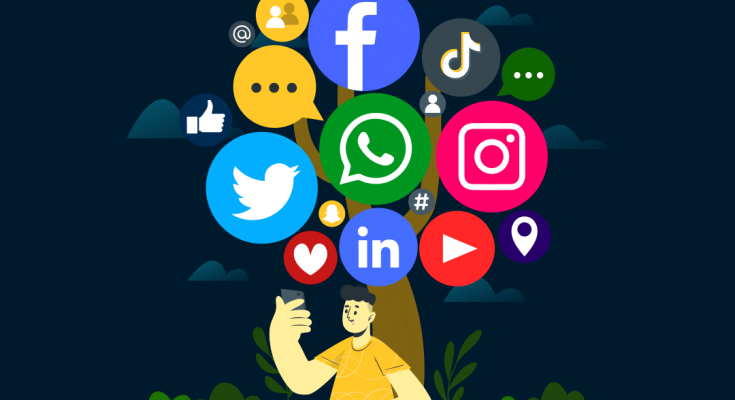Social media marketing is one of the fastest-growing industries in today’s digital world. Social network sites like Facebook, Instagram, Twitter, and Linked In have become increasingly popular, without a doubt.
Almost no people do not have access to a cell phone. This is where most marketers convert roughly 66 % of their leads with the help of social media platforms.
The power to reach thousands or even millions at once can be daunting for any business owner who isn’t already established on these platforms. Still, there are ways you could make your profile pop if it doesn’t seem interesting enough!
But first, if you want to learn just about everything there is to know about using social media to make money, take this online digital marketing course to boost your online presence and earn money using social media.
I’ve created a simple question to ask yourself so that anyone interested will know what steps they should take next after choosing their networks carefully:
1. Identify Your Social Media Strategy Objectives
The goal of your social media channels is to help you reach your strategic objectives. It’s important that these platforms are able and linked together so they can be used as a single integrated system for reaching high-level goals, such as those detailed below:
If You’re Looking to Raise Brand Recognition
To get the most out of your social media marketing campaign. Platforms such as Facebook and Instagram have proven themselves time after again when delivering excellent results for advertisers who choose them wisely and creatively!
If You Want to Boost the Number of Leads
LinkedIn is a terrific location to find leads in the social media realm. This networking site has everything, whether you’re looking for new connections through groups or guidance on how to handle your latest project.
Facebook’s advanced filters make it easy to find business contacts by allowing users to search not only by interests but also by location, making connecting easier than ever before, making them ideal prospects if they live nearby.
Whereas Twitter can be used simply because someone is always talking about what we do and even posting photos!
2. Which Channels Does Your Target Audience Use?
Having an audience tailored to your business goals can help you evaluate where they interact online after connecting.
For example, maintaining a Snapchat account for the sake of older women may not be worth it because their primary customer demographic, 55+ years old, isn’t on social media platforms like this anymore.
Similarly, men might want different content than what’s being shared through Pinterest which tells us specifically how many people visit based on gender/age!
These data-driven insights will ensure we’re providing relevant strategies and selected channels to get paid attention from potential buyers.
So, think carefully about which platforms are necessary for your selling.
3. Which Channels Do Your Competitors Use?
To stay ahead of your competition, you need a full understanding and knowledge base of the most relevant platforms.
Examining these will help provide an accurate comparison between industry activity on them vs other accounts in similar fields; this way, it’s easier to decide which steps should be taken next!
How Do They Post Content? How Often Do They Post It? What Is the Number of Likes and Shares?
Understanding what your competitors are doing on social media can be an important tool for ensuring that you’re not leaving any stone unturned in the search to outrank them.
Examining how active they stay and whether their followers respond positively or negatively when commenting about posts reveal data that could help us understand where we need improvement as a business and maybe even give us some ideas about new strategies!
Do You Have a Specific Type of Content in Mind?
So, what kind of content is good on social media?
Suppose you’re a business trying to reach out to your target market with useful information about how they may save money or get more productivity out of their office space. In that case, social media channels like Facebook and Twitter are likely to be the best options.
Suppose all that counts is that you spend enough time catching up after work hours. In that case, you’ll find plenty of opportunities in curated newsfeeds like LinkedIn Daily Notes or simply subscribing to where sites publish items specifically geared to professionals working late nights.
Keep your company’s or personal Twitter feeds updated with industry-specific material and lively discussions.
Sharing articles relevant to what you do as a service, for example, if it’s marketing, giving people an inside look into how things function at the home base through live feeds of office surroundings – whatever best matches their needs – is a wonderful way to accomplish this.
What If You Share a Video Content?
YouTube is the second most popular search engine globally, with over 3 billion searches every month. It’s a great platform to post your videos if you want them seen by more than just people in specific demographics or regions of interest!
What If You Share an Image of Content?
The visual elements of your company’s brand should be on every channel where they can reach potential customers, which is why it makes sense for B2C companies to take advantage!
Pinterest has been identified as one place Shopify users go before purchasing items.
93% or, more often than not, plan their purchase through this app, too – so make sure you’re checking out these boards closely if you want the best chances at success with advertising through social media channels like Instagram and Tumblr. Instagram marketing is great to build your brand online.
c) What If You Share an Editorial Content
LinkedIn is a great way to publish your article and make it available to people worldwide. With 300 million members, you’re bound to have some serious reach!
The best part about LinkedIn is that? It would be free of charge if that were ever something holding me back from joining up before now.
Suppose publishing on medium sounds more appropriate based on their customer base demographics 43% earn six figures or more. This platform also allows authors’ posts to go viral with minimal effort because they can do so easily through hashtags.
Are you tired of searching for content for various platforms? Our digital marketing agency experts can help you in reaching out with your content with no work on your part at an affordable cost.
5. What Is the Maximum Number of Channels You Can Handle?
With more retailers experimenting with social media, finding the correct balance when using platforms like Facebook. If you post too frequently on a single channel, your brand may suffer from low exposure or reach;
Nevertheless, if you don’t post, how will anybody know about your favorite company’s good deeds? You can utilize programs like Buffer (on occasion) to schedule posts in advance via various accounts like Twitter and Instagram while conserving time during the day, which is always busy work!
You can share the same content across all of your platforms or customize postings for specific ones using the sharing options. Buffer also allows you to post images, which is important because content with relevant images receives 94% more views than content without!
Handling so many platforms at once is getting tougher day by day? join our digital marketing course to become a social media pro in no time by automating your post effortlessly.
Conclusion
As you can see, automating your social media marketing is a great way to save time and energy while still reaching a large audience.
However, it’s important to remember that not all platforms are created equal, so start small and only add new channels once you’ve perfected the ones you already have.
And most importantly, be sociable!
Share what you’ve learned with your followers after reading this blog post. We hope you enjoy putting these tips into practice!




